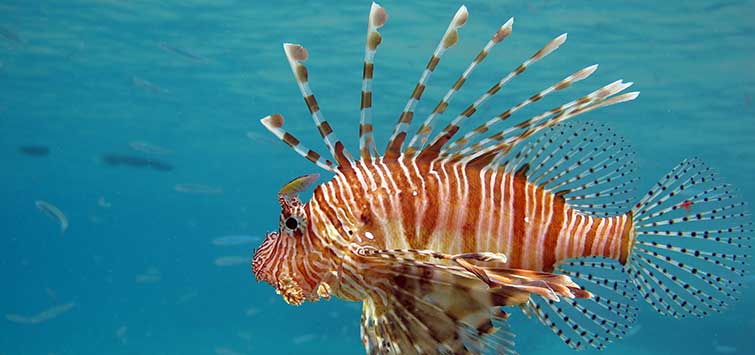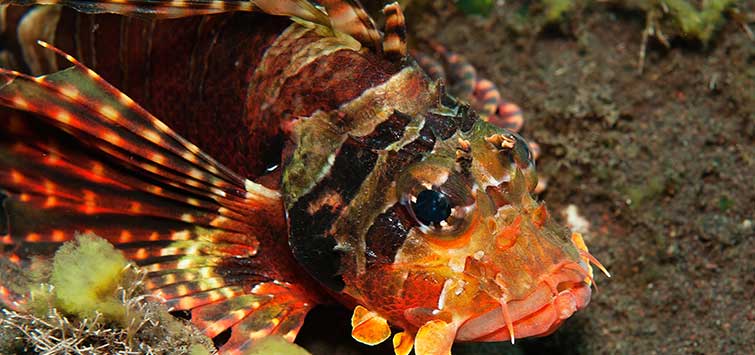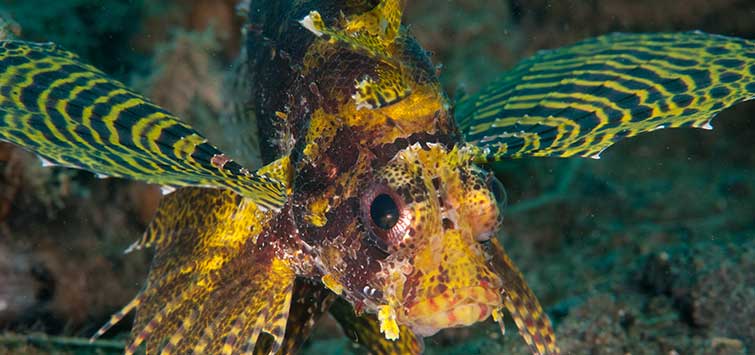Hunting Lions in the Bahamas
Author: Rick Oellers
Lionfish are extremely popular as aquarium inhabitants, but they are unwelcome as Bahamas’s near-perfect predatory invader. Our author dives into the invasion and reports on its extent and the potential impact to the reef ecosystem.
Into the Lion’s Reef
Nestled between two coral heads, I take a breath on my scuba regulator and look around at the wonderful underwater world that surrounds me. The rising sun sends glittering lines dancing across the sand patch on which I lie. I slowly exhale, and my bubbles startle several blue chromis that have been swimming above me. A school of snapper cruises by on their way to an early morning breakfast. Their sound fills my ears, alongside the crunching of the thousands of shrimps and parrotfish making their daily routine of life on the reef.
Picture Time
An angelfish swims in front of my mask as if to say, “Hey, take my picture.” If it were any other time, I would have been thrilled to snap a photograph of this blue and yellow beauty, but this fish is blocking my view of what was 4 feet in front of me—three 8-inch lionfish, which is what I have traveled here to study. The pectoral fins appear to be a robin’s egg blue and are enhanced by dark brown/orange and white stripes. I have kept lions in aquariums for years, but the beauty of them in the wild eclipses those kept in captivity by far.
The sound of bubbles being exhaled into the crystal-clear water break my trance. My dive partner, Bob Sterling, is lying in the sand as well, jotting down notations. I glance at my watch and the second hand reminds me to mark the behavior of the lionfish I had been assigned. I make a check mark on my underwater clipboard to indicate that my fish is active, but not swimming.
The Hunt
Suddenly, his antennae perk up and he silently glides forward. In the blink of an eye, he attacks a small goby, but the goby is quick and escapes his hunter’s vacuum-like mouth. The lionfish settles back down, as he knows there is a lot more food swimming and crawling around this coral head. He doesn’t have to move far to hunt—a buffet of small fish and crustaceans surrounds him. As a matter of fact, these lionfish have not moved more than 6 feet since we found them the day before.
Where in the World?
Most marine aquarists would presume I am diving in the Indo-Pacific, but they would be surprised to find that I am actually doing lionfish research 40 miles northeast of Grand Bahama Island. I am here working with the Reef Environmental Education Foundation (REEF) and the National Oceanic Atmospheric Administration (NOAA) to gather information on what could be an environmental catastrophe that could devastate the Bahama Islands’ ecosystem.
Everywhere a Lionfish
“Near-perfect invader” is what our team leader, Lad Akins of REEF, called the lionfish Pterois volitans during our briefing two days earlier. It was my first day aboard the sloop Pirate’s Lady. There were eight of us gathered around a table in the salon below deck. I was lucky to be invited to participate in this project due to my affiliation with the nonprofit group Touch Tanks for Kids. Lad was giving us a rundown of the history, biology, and potential threat these beautiful species pose to the native fish population.
Lad went on to explain that lionfish had never been seen here prior to 2004, and now, three years later, they appear to be prevalent around the main islands and waterways. Our trip would take us northeast to areas not frequented by dive operations or tourists. Previous expeditions had taken place in the areas around the regular dive sites, and lions had been found to be well established and reproducing with an increase of population at an estimated rate of a thousand percent a year!
Catch of the Day
The next day, as I took a giant stride off the starboard side of the boat, I wondered if I would be lucky enough to even see one during the week. However, I realized the scale of their infestation when, after reaching the bottom of the anchor line, I looked to my right and there, sitting on the anchor itself, was a lionfish.
Lad was to meet me there on the bottom with nets to show me the proper method of catching these venomous creatures without getting stung. Lad and another researcher, Jim, carried the nets, and I held the plastic catch bags that would hold the captured fish. Unfortunately, my dive buddy, Bob, had some problems clearing the water pressure in his ears, so it took longer to descend than we expected. When we got to the bottom, Lad and Jim were nowhere to be found. Without a net, catching this fish would be impossible, right? Wrong! I am an aquarist—who needs a net? Bob held open the catch bag as I herded the lionfish into it.
An hour later, to Lad’s amazement, Bob and I climbed aboard the Pirate’s Lady with three significantly sized lionfish in one large plastic bag. Lad chewed me out as to the carelessness of catching the fish this way, and I promised to learn the proper method.
Traveling Lionfish
The question is this: Where did these fish come from? I heard stories of lions being sighted by divers off North Carolina since the mid-1990s, and I always assumed it was just a scuba diver’s equivalent of an urban legend. It wasn’t until the late 1990s that photographs were turning up, and a concerned NOAA sent a team down to investigate this phenomenon. The fish were indeed there. On one dive, the team pulled up 28 full-grown lionfish off a shipwreck.
Invasive Species
In 1998, the lionfish had been officially recognized as being the first tropical marine ornamental fish to be declared as an invasive species. Over the next few years, they slowly increased in number up and down the East Coast and have been spotted as far north as Long Island. There is a very large population off North Carolina.
Where Did They Come From?
How they got there is still up for debate. Some believe that eggs were released with ballast water from ships traveling from tropical Pacific seas. Others believe that the fish may have been accidentally released in a shipment of tropical fish in a plane crash, and of course, there are those who are quick to point the finger at the aquarium hobbyist.
During Hurricane Andrew in 1992, six lions were accidentally released in Biscayne Bay outside Miami when the aquarium they were housed in was washed into sea. They were seen swimming in the bay in the following months. Since lionfish eggs are buoyant for up to three days, it is a real possibility that the eggs and larva may have caught the Gulf Stream, drifted up the coast, and settled off the North Carolina coast.
Widespread Infestation
The next question is, “How did the lionfish make the jump from the mainland North American coast to the Bahama Islands?” The Bahaman infestation appears to have originated from the North Carolina outbreak, and the fish simply swam the distance. Lionfish have been spotted in open water, swimming halfway between the East Coast and Bermuda, where they have also established themselves.
Other people feel that the release of eggs from the Atlantis resort in Nassau may be the culprit. When I asked Lad about that possibility, he explained that DNA testing on the Bahama lionfish had been done. The results have shown that the DNA of the lions in the Bahamas is more closely related to that of the fish found on the coast of the United States. Because of the cooler water of the mid-Atlantic coast, the lionfish have not spread as fast as the group in the Bahamas. Temperature plays a role in the fertility and frequency of their spawn. Due to the buoyancy of lionfish eggs, the swift-moving Gulf Stream may catch these eggs and push them out to cooler and deeper waters.
In the Bahamas, however, the temperature is much more favorable for lionfish spawn quality and frequency. With an abundant food supply and no predators, they have found the Bahama Islands a paradise to thrive. Females reach sexual maturity in only one year, spawn once a month, and can produce up to 30,000 eggs per spawn!
Dissecting the Problem
Not all of our dives were for observing lions. We spent most of the week reef-hopping and counting and collecting them. The reefs we visited were not on the regular dive site charts, so we were pretty much diving on virgin reefs. I only wish I had more time to look at the beautiful marine life that had not been spoiled by overdevelopment, runoff, or inexperienced/careless divers and snorkelers. We had no problem finding and catching lionfish.
Capturing Lions
The best method of capture was to sandwich the fish between two large nets with plastic sides and a mesh on the bottom. Once the lion was in the closed net, a diver would grip the fish on either side of its head. When it was stable, the diver would push the fish, caudal fin first, into the open catch bag held by the diver’s buddy. This was done literally by pushing the net inside-out into the catch bag. The bag was closed and fastened shut with plastic clips. By the end of the week, I had no problem catching the fish this way.
Once on deck with our catch, the fish were dissected and studied. The dissected fish organs were labeled and sent to Atlanta for further testing. This process was potentially difficult because there was a tropical storm southwest of us in Jamaica, and the swells made our deck pitch and heave. Two members of our team received some nasty stings from the spines of the lionfish, and I realized the truth behind two myths regarding their spines. First, contrary to popular belief, the spines that are venomous are only on the dorsal fins (13), the pelvic fins (2), and the anal fins (3). The beautiful pectoral fins are not venomous. I now understood why, during the many times lionfish have brushed by my hand with its pectorals, I did not receive a painful stab.
Dissection
Second, the spines are not hollow with poison sacks located at the base. The cross section of a lionfish spine is T-shaped, and the glandular complex that produces venom is located in the anterolateral grooves of this T. When the spine punctures its victim’s skin, the outside tissue slides back and the spine enters the victim. As the spine pulls out, the tissue slides off and stays in the victim, leaving behind a very painful experience. Though the pain is intense, it is not life-threatening unless there is an allergic reaction. The best treatment is to run very hot water over the wound and wait for the pain to subside. Our boat had medication onboard in case there was a reaction, but fortunately it was not needed.
The dissection process included two team members. As the researcher gathered information during the process, he or she would call out the results to another team member, who would write the results on a log sheet. After our dissection table was set up, we would euthanize our fish by an approved and humane method prior to dissection.
Our Findings
There are actually two species of lionfish infesting the East Coast and its neighboring areas. The majority of the invasion consists of the red volitans lionfish Pterois volitans, which is primarily sold to the aquarium hobby. However, there is also a population of Pterois miles. According to Lad, the only sure way to tell the difference between the two is through their DNA.
Once euthanized, the fish was placed on the dissection pad, and measurements were taken of the length of the fish. If antennae were present, we would document if they had a peacock-type plume on the end of each, as there is research being done on their function and evolution.
Stomach Contents
We next took our dissection scissors and cut the abdomen of the fish from the anus to the base of the skull and the gill lines. This allowed us to open its belly cavity to extract the reproductive glands and stomach contents. The gonads and ovaries were located on either side of the swim bladder. These were removed, a notation of the sex of the fish was made, and the organs were placed in a vial and put on ice to be shipped to Atlanta.
The stomach was then removed and cut open, and the contents were removed and identified if possible. The mass of the contents were determined and logged, along with the identification of the lion’s last meal. What was disturbing to me and the other researchers was that the contents of the fish’s stomach revealed that nothing crawling or swimming escaped the lionfish’s ravenous appetite. We even found a mantis shrimp in the belly of one. Commercial fish, such as juvenile groupers, have also been found in the stomachs of this voracious predator. This lends credence to the fear that if their population continues to grow exponentially, the larger food fishes will not only fall victim as juveniles, but they will also be outcompeted for a food source.
Brain
After the body cavity dissection was finished, the head of the fish was cut off with a large knife, and the brain cavity was then cut open. (It just didn’t seem right slicing off the head of a $100 lionfish, though!) Using jeweler glasses and tweezers, we carefully removed the tiny otolith bones located on either side of the brain cavity, which function for hearing. Biologists are able to determine the age of the fish by counting tiny rings in the bone, very similar to what is done for trees. This proved to be very frustrating, however, due to the rocking and rolling deck. The bones were also hard to find, and they were extremely fragile. The tiny bones were placed in a vial and sent to Atlanta with the other samples.
Cloudy Future
As the week progressed, we found lionfish everywhere. I estimate that in some places, we could find one every 40 meters (130 feet). Considering that the species was not even discovered in Bahaman waters until 2004, the increase in population is alarming to say the least. We even found them in canals and waterways.
What disturbs me is that in every research paper I have read, the blame is usually placed upon the aquarium hobby and industry. As a professional aquarist for over 25 years, I have seen the results of legislation putting pressure on the collection and importation of marine fish and invertebrates. The rapidly evolving threat that lionfish pose to Bahaman waters should be a wakeup call to all marine aquarists.
Unless the marine aquarium industry, hobbyists, and clubs make a pre-emptive, conscious effort to educate home aquarists on the possible impact of releasing a non-native species into the wild, I fear that public outcry could lead to restrictive policies placed on the aquarium industry.
As I touched down in a snowy Portland, Maine the following Sunday, I found it hard to get my mind focused back to my company and its everyday challenges. My thoughts drifted back to the week that I spent with Lad Akins of REEF, the wonderful crew of Pirate’s Lady, and the rest of the expedition group. It proved to be one of the best experiences of my life.
See the full article on TFH Digital http://www.tfhdigital.com/tfh/200904/#pg101

.png?h=595&iar=0&w=2781&hash=5FD5E69473BCC22199FBFA2FB71B6033)



